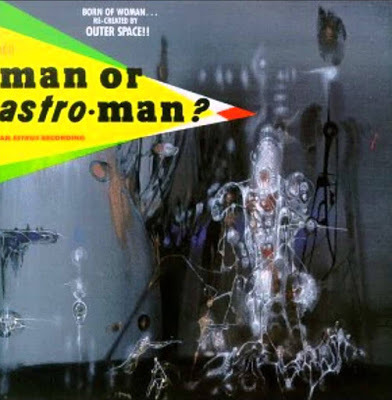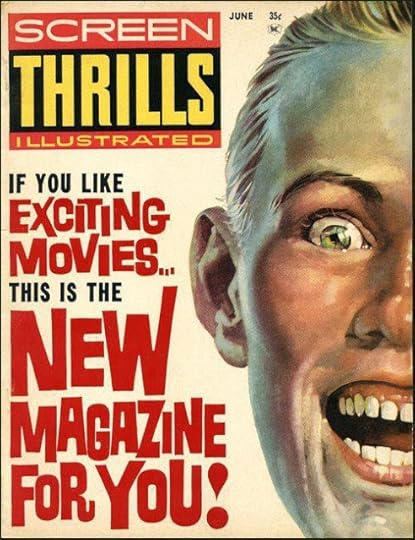Read this graphic design book: 'Art Chantry Speaks'!
I write the occasional comic book, and I talk about the occasional movie, but what I do for a living is marketing, with a focus on graphic design. Before I studied journalism in college, I studied design, and I remain fascinated by it to this day. And, given my undying interest in the dark, forgotten corners of pop culture (something you must have noticed if you’ve read this blog for more than five minutes) I prefer looking at the offbeat designs and designers. Anyone can read another diatribe about Paul Rand or Pushpin Studios, but gimme the old stuff (Norman Bel Geddes!) the weird stuff (Punk Magazine!) or the weird, old stuff (the graphic design of totalitarian states!) I’ll cover those books in upcoming posts (I promise), but in the meantime, let me point you in the direction of the best design book I’ve read in a while, “Art Chantry Speaks: A Heretic’s History of 20th Century Design” by (who else?) Art Chantry.

Chantry is a graphic designer based in the northwest often credited with originating the somewhat retro, consistently clever, usually homemade look of the grunge rock era. In his designs for posters, albums, magazine and ads, he delved into pop culture’s past, using imagery from old monster movies, supply catalogs and pin-up magazines to deliver designs that, if not wholly unique, were wholly American. There’s a hefty monotype of his work, “SomePeople Can’t Surf: The Graphic Design of Art Chantry,” that I highly recommend.
But its “Art Chantry Speaks” that, though smaller, is more intriguing. In dozens of essays, Chantry examines the graphic design that we see every day, that we grew up with, that shaped our vision of the world in countless weird little ways. He examines who really created the once-ubiquitous smiley face icon; proves that the psychedelic designs we’re most familiar with come courtesy of Hallmark, not Peter Max; and gives props to mid-century satire with a history of that Alfred E. Neuman face and a loving tribute to Harvey Kurtzman’s legendary magazine, Help. All great articles, and all amply illustrated with images from Chantry’s personal files. But that’s not the best stuff in “Art Chantry Speaks.” Where the book really soars, and where you can really feel Chantry’s love for his subject matter, are the sections where he dives deep, reminding you of images you barely remember seeing, then revealing how they came to be in the first place.

There’s a great chapter on Richard W. Powers, an artist who created some truly mind-bending covers for science fiction novels in the ‘50s and ‘60s. In a twist ending, Chantry tracked him down in the ‘90s, after he’d retired from the cover biz for a lucrative fine art career, and hired him to illustrate the cover for the debut album of the sci-fi-inspired band, Man … or Astroman?
In a more lowbrow vein, Chantry takes a long look at various forms of cheap, disposable religious propaganda – banners, flyers and inspiration novels – and tries to uncover inspiration behind these decidedly unsophisticated designs. In a surprising move, he points the finger at legendary artist Henri Matissa (and make a solid case for him, at least as far as the banners go). Then, in a second surprising move, he pieces together who the artists of those forgotten novels were (you know, the ones that have titles like “The Lonely Now” and introductions from guys like Art Linkletter). It’s the sort of cultural detective work that almost no one is willing to do -- but that almost always yields interesting results. That certainly the case here.

And then there’s what might be my favorite chapter in the whole book, “Harry Chester, King of Monster Type,” which examines the work of the improbably named Mr. Chester. As Chantry says “Harry Chester was the designer/art director who became the right hand for this weirdo crowd. Whenever there was a magazine or a page or book to design, he was there pasting it up.” He worked with guys like Jim Warren, Bill Gaines and the aforementioned Harvey Kurtzman, and he worked on magazines like Mad, Help Eerie, Creepy, Blazing Combat and Famous Monsters of Filmland. All classics of pop culture, and Chester did important work on them (he helped guide the transition of Mad from comic book to magazine, for instance). But what Chantry really likes about Chester – and what you will too, after reading this chapter -- is the lettering he did for Famous Monsters and other over-the-top publications. Beautifully designed, hilariously in-your-face and just plain fun, the headlines and type styles Chester created (by hand, of course) perfectly mirrored the playful articles and photos they accompanied. And, though the youthful audience probably didn’t notice it, those headlines were stunning examples of design, with powerful contrasts of line, shape and black-white. It’s great stuff, and though I’ve seen it before, I never would’ve appreciated it without Chantry’s enthusiastic prose to guide my way.
“Art Chantry Speaks” is full of that sort of article, well-written (and well-illustrated) reminders of how much fun design can be. Like I said, I was a design major in college for a couple of years, and there’s nothing that can drain the fun out of graphic design like listening to some burnt-out professors drone on about the same three names you’ve heard a million times. Chantry’s book, which mentions those names only in passing (and usually in sarcasm – there’s a chapter titled “Saint Paul”) should be on the syllabus of every design prof in the country. It would wake up the students, invigorate the classwork and, in eventually, make the world a more interesting-looking place.
“Art Chantry Speaks,” by the way, comes to us courtesy of the fine folks at Feral House, one of the most interesting publishers on the planet. I don’t own every book they’ve published, but I do seem to own most of them. Check them out at feralhouse.com

Chantry is a graphic designer based in the northwest often credited with originating the somewhat retro, consistently clever, usually homemade look of the grunge rock era. In his designs for posters, albums, magazine and ads, he delved into pop culture’s past, using imagery from old monster movies, supply catalogs and pin-up magazines to deliver designs that, if not wholly unique, were wholly American. There’s a hefty monotype of his work, “SomePeople Can’t Surf: The Graphic Design of Art Chantry,” that I highly recommend.
But its “Art Chantry Speaks” that, though smaller, is more intriguing. In dozens of essays, Chantry examines the graphic design that we see every day, that we grew up with, that shaped our vision of the world in countless weird little ways. He examines who really created the once-ubiquitous smiley face icon; proves that the psychedelic designs we’re most familiar with come courtesy of Hallmark, not Peter Max; and gives props to mid-century satire with a history of that Alfred E. Neuman face and a loving tribute to Harvey Kurtzman’s legendary magazine, Help. All great articles, and all amply illustrated with images from Chantry’s personal files. But that’s not the best stuff in “Art Chantry Speaks.” Where the book really soars, and where you can really feel Chantry’s love for his subject matter, are the sections where he dives deep, reminding you of images you barely remember seeing, then revealing how they came to be in the first place.

There’s a great chapter on Richard W. Powers, an artist who created some truly mind-bending covers for science fiction novels in the ‘50s and ‘60s. In a twist ending, Chantry tracked him down in the ‘90s, after he’d retired from the cover biz for a lucrative fine art career, and hired him to illustrate the cover for the debut album of the sci-fi-inspired band, Man … or Astroman?
In a more lowbrow vein, Chantry takes a long look at various forms of cheap, disposable religious propaganda – banners, flyers and inspiration novels – and tries to uncover inspiration behind these decidedly unsophisticated designs. In a surprising move, he points the finger at legendary artist Henri Matissa (and make a solid case for him, at least as far as the banners go). Then, in a second surprising move, he pieces together who the artists of those forgotten novels were (you know, the ones that have titles like “The Lonely Now” and introductions from guys like Art Linkletter). It’s the sort of cultural detective work that almost no one is willing to do -- but that almost always yields interesting results. That certainly the case here.

And then there’s what might be my favorite chapter in the whole book, “Harry Chester, King of Monster Type,” which examines the work of the improbably named Mr. Chester. As Chantry says “Harry Chester was the designer/art director who became the right hand for this weirdo crowd. Whenever there was a magazine or a page or book to design, he was there pasting it up.” He worked with guys like Jim Warren, Bill Gaines and the aforementioned Harvey Kurtzman, and he worked on magazines like Mad, Help Eerie, Creepy, Blazing Combat and Famous Monsters of Filmland. All classics of pop culture, and Chester did important work on them (he helped guide the transition of Mad from comic book to magazine, for instance). But what Chantry really likes about Chester – and what you will too, after reading this chapter -- is the lettering he did for Famous Monsters and other over-the-top publications. Beautifully designed, hilariously in-your-face and just plain fun, the headlines and type styles Chester created (by hand, of course) perfectly mirrored the playful articles and photos they accompanied. And, though the youthful audience probably didn’t notice it, those headlines were stunning examples of design, with powerful contrasts of line, shape and black-white. It’s great stuff, and though I’ve seen it before, I never would’ve appreciated it without Chantry’s enthusiastic prose to guide my way.
“Art Chantry Speaks” is full of that sort of article, well-written (and well-illustrated) reminders of how much fun design can be. Like I said, I was a design major in college for a couple of years, and there’s nothing that can drain the fun out of graphic design like listening to some burnt-out professors drone on about the same three names you’ve heard a million times. Chantry’s book, which mentions those names only in passing (and usually in sarcasm – there’s a chapter titled “Saint Paul”) should be on the syllabus of every design prof in the country. It would wake up the students, invigorate the classwork and, in eventually, make the world a more interesting-looking place.
“Art Chantry Speaks,” by the way, comes to us courtesy of the fine folks at Feral House, one of the most interesting publishers on the planet. I don’t own every book they’ve published, but I do seem to own most of them. Check them out at feralhouse.com
Published on July 29, 2016 20:01
No comments have been added yet.
Will Pfeifer's Blog
- Will Pfeifer's profile
- 23 followers
Will Pfeifer isn't a Goodreads Author
(yet),
but they
do have a blog,
so here are some recent posts imported from
their feed.



